The Gray Market
What Goldman Sachs’s Florida Expansion Tells Us About the Future of the Art Market (and Other Insights)
Our columnist sees the mega-bank’s plans for West Palm Beach as the latest sign the South Florida art market is here to stay.
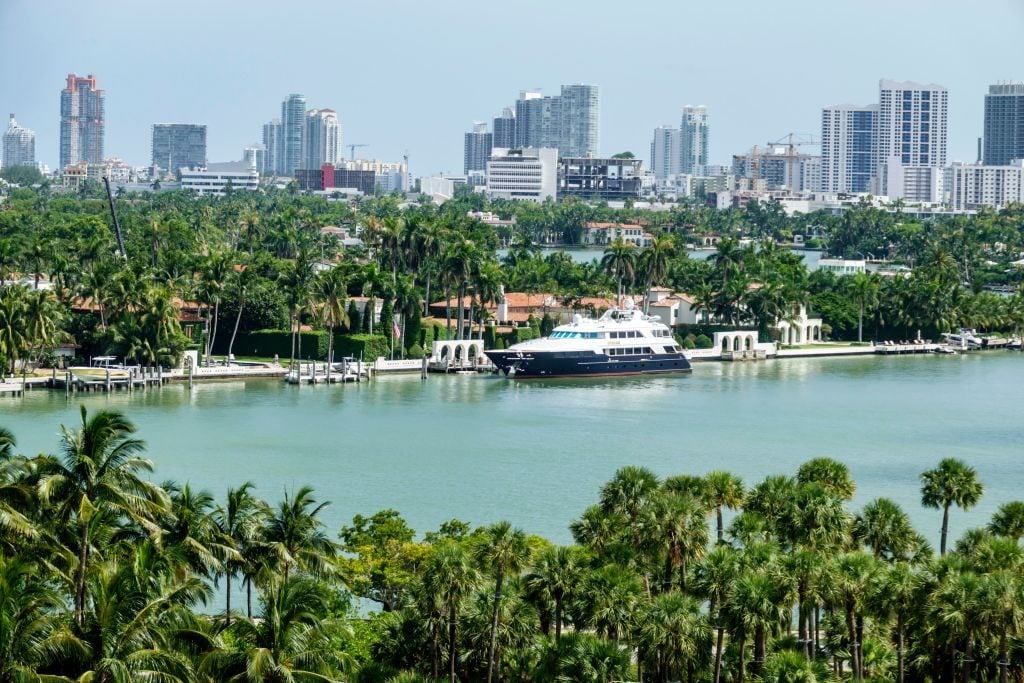
Our columnist sees the mega-bank’s plans for West Palm Beach as the latest sign the South Florida art market is here to stay.

Tim Schneider

Every Wednesday morning, Artnet News brings you The Gray Market. The column decodes important stories from the previous week—and offers unparalleled insight into the inner workings of the art industry in the process.
This week, an update on the conjoined fates of the post-shutdown art and business worlds…
Last Monday, Dakin Campbell of Insider reported that Goldman Sachs is “in the early stages of moving traders and salespeople to Florida” from its New York mothership for the long haul. It’s the latest sign that one of the major migrations of wealth sparked by last year’s lockdowns will have staying power. It’s also further validation for every art-market player who bet big on the Sunshine State during the dark days of 2020.
According to a person with direct knowledge of the talks, Goldman is planning to relocate more than 100 of its best and brightest to an office it will establish in West Palm Beach. Campbell relays that the cadre of cash generators is “expected” to feature some of “the bank’s most senior executives, those 400 or so partners who earn almost $1 million and get a cut of a special bonus pool.”
Also in the conversation is some number of “high-performing managing directors or vice presidents” whose move to Florida would “signal that the office won’t be considered a backwater that kneecaps their Wall Street career,” in Campbell’s words.
While Goldman appears to be the first major bank to put South Florida onto its strategic roadmap, other banner names in high finance got ahead of it months ago.
Point72 Asset Management, the behemoth run by billionaire collector Steven A. Cohen, signed a lease in Miami’s Brickell Financial District in April and also plans to have a West Palm Beach office up and running this summer. Citadel, the towering investment group led by Whitney Museum trustee and guy-who-privately-ran-up-$500-million-on-two-paintings Ken Griffin, is now looming over tens of thousands of available square feet in Miami Beach. Elliott Management, a hedge-fund heavyweight known for shaking up the strategies of the companies it buys into, signaled last year that it would relocate its headquarters to Florida. And that’s just a sample.
These names and ranks likely mean very little to a lot of readers, so let’s simplify it with hard numbers.
Point72, Citadel, and Elliott together manage close to $100 billion in assets, per a smattering of reliable publications. Goldman supervises around $1.8 trillion (yes, with a “tr”) worldwide according to its website.
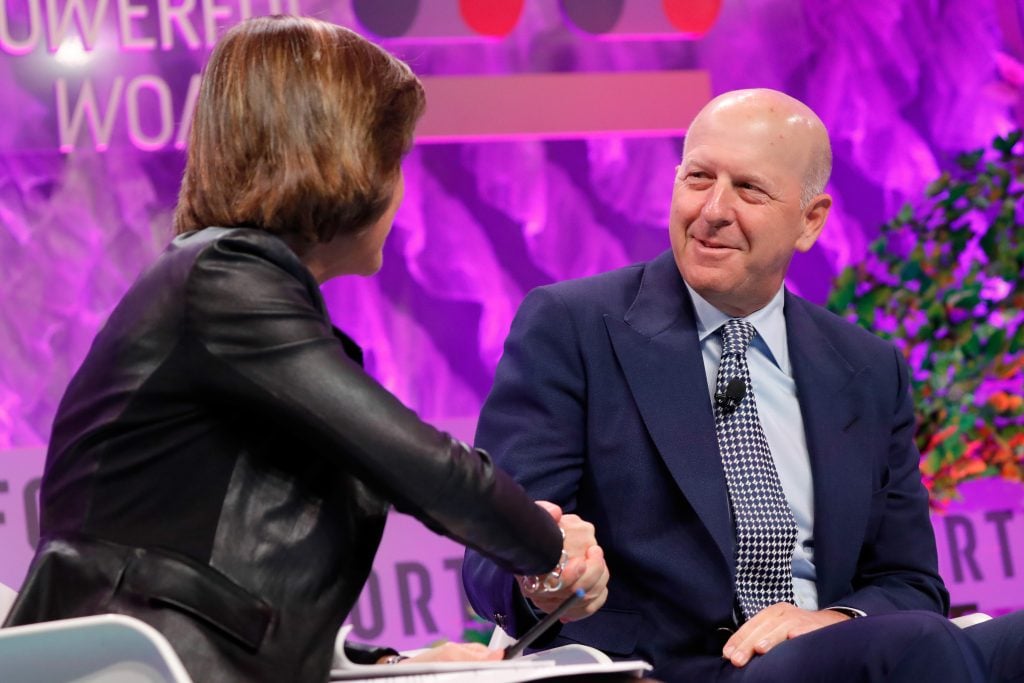
Current Goldman Sachs chairman and CEO David Solomon onstage at the Fortune Most Powerful Women Summit with the event’s executive director, Pattie Sellers, on October 10, 2017 in Washington, D.C. (Photo by Paul Morigi/Getty Images for Fortune)
These Wall Street hulks will continue to station hundreds, if not thousands, of their high-earning dealmakers in other locations. But they are also responsible for an inrush of wealthy personnel poised to make their homes and spend their fortunes in the 70 miles of coastline between West Palm Beach and downtown Miami. That creates a huge opportunity for anyone selling the finer things in life, including blue-chip art.
Several top-tier names in the art market positioned themselves to take advantage last year. By the time Zombie Art Basel lurched into the humid December night, West Palm Beach had become a seasonal haunt for the likes of Acquavella, Paula Cooper, and White Cube.
Other names circling the market’s pinnacle made longer-term commitments immediately: Lévy Gorvy will program its space in West Palm Beach through at least March 2022; Pace and Sotheby’s will each operate their respective locations in the city year-round. Paula Cooper also reversed its original plan this April by announcing its West Palm Beach space would be permanent—its first ever gallery outside New York.
Based on Wall Street migration patterns, my guess is the dealers and houses that set down firm roots on the beach are ecstatic about the choice. I’d wager that at least some of those who wound down their Florida outposts in springtime are having second thoughts, and I guarantee several of their competitors are investigating how and when to horn in. The end result could permanently reshape the geography of the high-end art market, largely thanks to a civilizational upheaval almost no one saw coming… and a regulatory disparity that has been unmistakable for years.
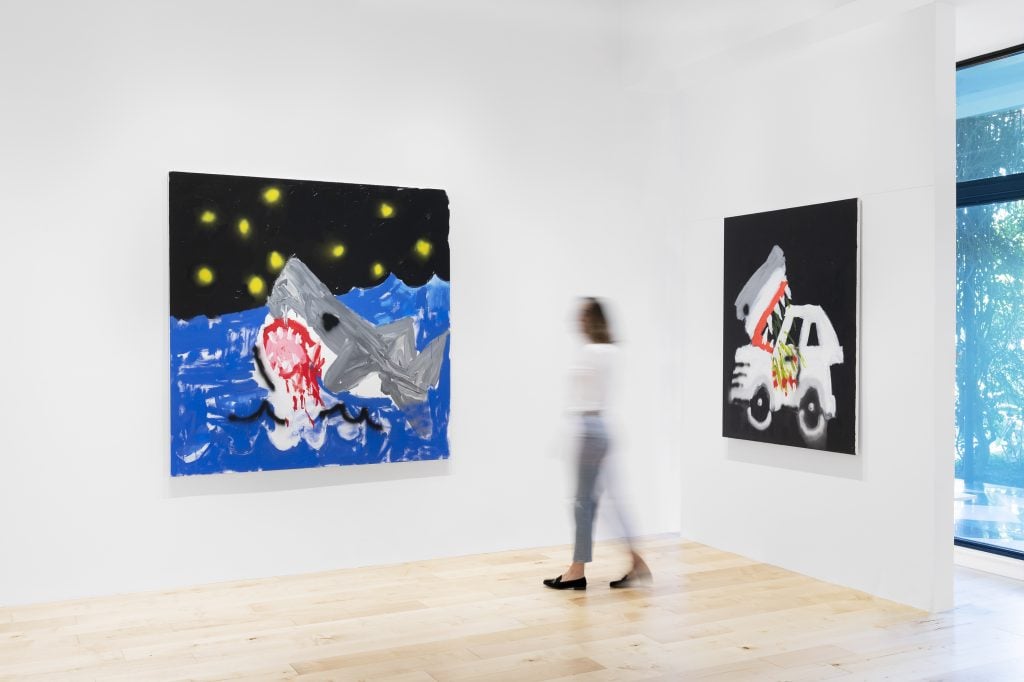
Installation view of “Robert Nava” solo show at Pace Gallery in Palm Beach, January 2021. Courtesy of Pace.
It’s no secret that a significant number of high-earners bailed on New York during the scariest stretch of 2020 or that many, if not most, stayed gone until vaccines became widely available just a few months ago. That made last year something of an impromptu audition for a slew of locales outside the tristate area that afforded wide-open spaces and top-dollar creature comforts. Miami and West Palm Beach were prominent among them.
Yet it’s important to recognize that those two cities had been building up their luxury infrastructure long before the social-distancing era. As my colleague Nate Freeman pointed out in his sneakers-on-the-ground reporting in December, Palm Beach County was home to more than 70,000 millionaires as far back as 2014, per CNN Money. Miami and its beaches have been a haven of wealth since before the Rat Pack was debauching the original Fontainebleau.
Longtime Miami-based collector Dennis Scholl, who doubles as the president and CEO of the nonprofit residency program and exhibition space Oolite Arts, confirmed that Miami and West Palm Beach “have emerged as places with a lot more quality of life benefits than they were perceived to have had in the past.” Both cities now offer top-flight museums and “an excellent, diverse group of visual artists,” as well as other cultural assets ranging from ballet and symphony orchestras, to a “very strong” food scene and emerging film community.
(He also added that the relocation wave is carrying a raft of startups and established tech companies to South Florida right alongside the banks and hedge funds.)
Several art dealers who followed (or anticipated) the shift have already benefited. “The galleries that did pop-ups in Miami and Palm Beach have told me that they were pleasantly surprised at the response, both in terms of the quality of face-to-face conversations they had with visitors to the shows and the ultimate result: sales,” Scholl said.
Even as a veteran collector, he was impressed by the quality of the programming, which he summarized as “big-time artists showing big-time work.” Little wonder, then, that more and more major buyers and sellers alike have gravitated to South Florida in 2021.
Scholl also highlighted the least sexy but perhaps most important factor in this ongoing wealth migration: one of the friendliest state tax regimes in the nation. Florida charges residents no personal income, estate, or capital gains taxes—an especially seductive proposition for high earners with bulging investment portfolios.
This brings us back to Goldman Sachs. According to one person directly involved in relocation talks, the bank is further incentivizing its top staff to call the moving trucks by permitting them to keep their New York salaries and bonus packages if they head south. Campbell of Insider relays that Goldman partners clear $950,000 in annual salary and net “millions more in bonuses and income from the firm’s private investment funds.” Thanks to Florida’s tax largesse, the bank’s decision to hold compensation steady for transplants would amount to an instant, significant raise for execs, traders, and salespeople ready to punch a one-way ticket to Florida.
But the financial appeal extends beyond what the wealthy won’t have to pay in Miami or Palm Beach. It also concerns how much more they’ll soon have to pay if they stay in New York.
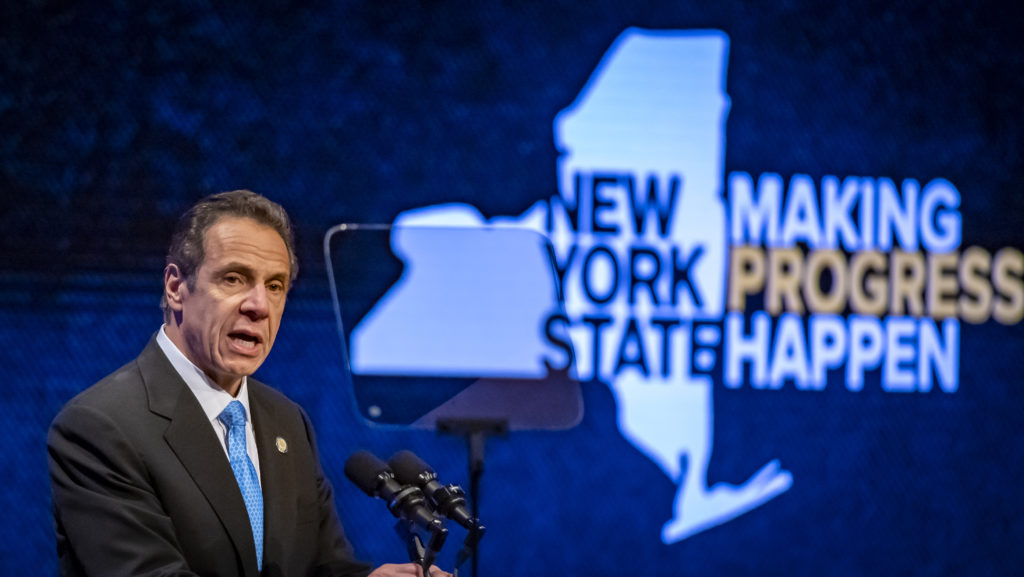
New York Governor Andrew Cuomo during his 2020 State of the State address in Albany, New York, on January 8, 2020. Photo by J.Conrad Williams, Jr./Newsday RM via Getty Images.
Back in April, the state of New York unveiled a budget engineered to rake in an additional $7.8 billion in tax revenue in the 2022 and 2023 fiscal years, largely by raising rates on its highest-earning residents. The tax on business income above $5 million will climb from 6.5 percent to 7.25 percent during those two years, partly to fund a cornucopia of disaster-relief initiatives for small businesses (including some in the cultural sector).
Personal income tax rates will also elevate for the two highest-earning brackets of New Yorkers: from 8.82 percent to 9.65 percent for the filers with annual income above $1.08 million, and to 10.9 percent for the filers with annual income above $25 million. Unlike the business tax increase, these higher rates will remain in force through 2027, channeling billions more dollars to Albany from the pockets of the state’s wealthiest demographics.
Multiple high-level art attorneys stressed to me in the spring that the specter of a higher federal tax burden would also influence top earners’ financial and lifestyle decisions. Based on the detailed tax plan President Joe Biden released at the end of May, the I.R.S. has never looked spookier to the investing (and collecting) class.
True to what the administration had signaled in the preceding months, Biden’s fiscal blueprint calls for $3.6 trillion worth of tax hikes on the U.S.’s richest residents and mightiest corporations. The personal income tax rate would ascend from 37 percent to 39.6 percent for individuals earning more than $452,700 and married couples earning more than $509,300.
More consequential still, the Biden plan would nearly double the capital gains tax, from 20 percent to 39.6 percent on investment income higher than $1 million. Factoring in additional fine-print surcharges and estate-related bills, the right-leaning Tax Foundation projected that the end result of Biden’s proposal in some states would be “the highest tax burden on capital gains seen in nearly a century.” Although the group did not name those states, I’m confident the list prominently features New York.
Biden’s tax plan may end up as a shadow of its current self by the time Congress gets done with it. But every high-earning American now knows that staying in the country could become vastly more expensive than it has been for generations. That prospect amplifies the value of every percentage point they could reclaim from state officials by uprooting their New York life for a fresh start in Miami or West Palm Beach.
Again, many members of this big money demographic already spent some portion of last year testing out the experience—and several were rewarded with their most lucrative year in business. Once you line up the Empire State’s definite increases with the I.R.S.’s possible ones, the full tax picture basically shows a 3D rendering of South Florida beaming a bridge made of stardust right onto Wall Street.
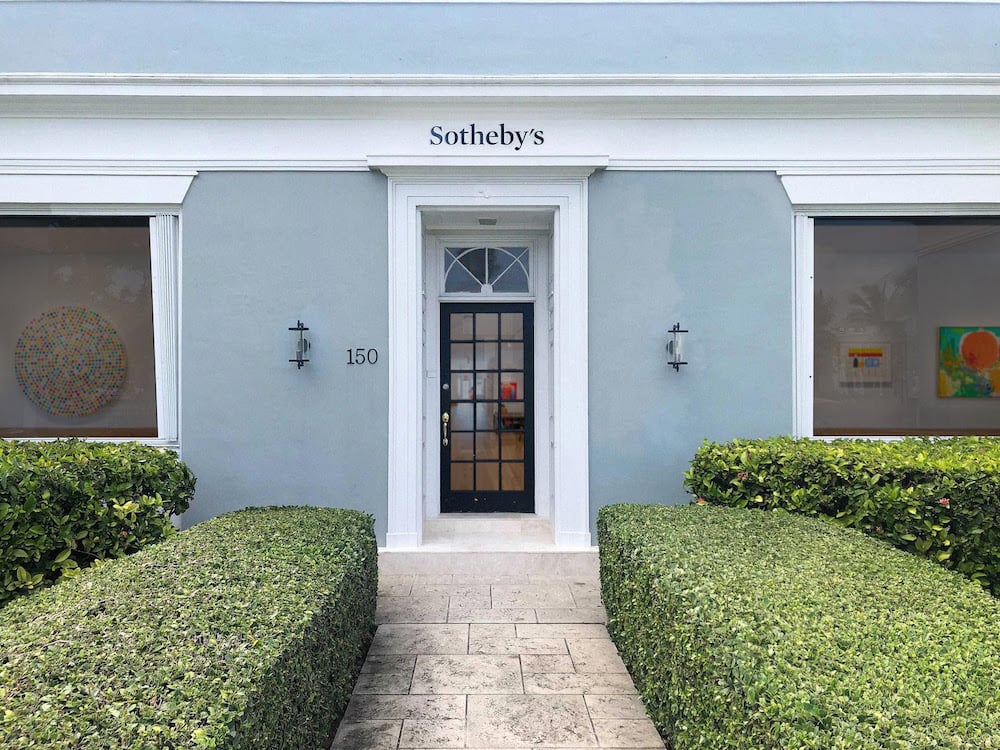
Sotheby’s new space in Palm Beach. Image courtesy Sotheby’s.
One person unsurprised by the growing throng of wealthy New Yorkers exploring the path south is attorney and art law specialist Thomas Danziger. Of the people I talked to about New York’s restructured tax code in April, he was the most bullish on its potential to spur collectors and high-net-worth individuals to uproot their lives for the southeast coast. When I circled back to him after reading news of Goldman’s expansion plan, he had this to say:
“Florida used to be known as ‘God’s waiting room.’ Given the number of our clients who are considering a permanent move there, God must be a very busy Florida C.P.A.”
Campbell of Insider called Goldman Sachs’s expansion to south Florida “a once unthinkable outcome for a firm that has counted New York home for 152 years.” It would be too strong to say the same about the galleries that have recently set down roots in the Sunshine State given their shorter histories, and Sotheby’s was a British company long before it began snaking its limbs around the world.
Still, few informed observers would have classified establishing a long-term presence in West Palm Beach or Miami as an urgent priority in the upper echelon of the art market as recently as 15 months ago, let alone even further back. Nevertheless, Wall Street’s southern migration is in the process of upending yet another tenet of industry orthodoxy.
The twist provokes two main questions for dealers, auction houses, and other art professionals without a Florida foothold: Is there a way to capitalize on the trend without breaking the bank? And either way, what other supposed pillars of wisdom might be riddled with hairline cracks if we examine them with fresh eyes?
That’s all for this week. ‘Til next time, remember what Victor Hugo wrote: nothing is more imminent than the impossible.